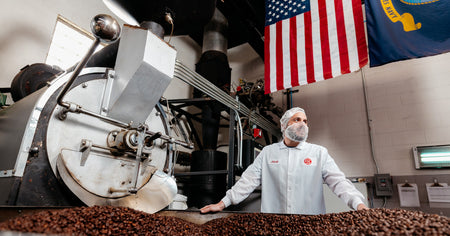July 11, 2021
The word acidity is usually associated with sour, acidic taste memories and accompanied by a disgusted reaction. So why do we hear about it so much in the magical world of java?
Because, in this case, coffee acidity means something else. Usually, something very positive!
Find out all about it so that you no longer feel the urge to recoil from coffee that’s described as ‘having high acidity.’
What does it mean when coffee is acidic?

When caffeine aficionados say that coffee is acidic, they refer to a range of bright flavors attributed to the acids that are naturally present in coffee beans.
For example, high-acidity coffee is usually quite vibrant and has fruity, critic or grapey notes.
It’s all about finding the right balance, though. If the coffee is far too acidic, it can actually end up tasting a bit sour. However, if it’s not acidic at all, it’ll be bitter and flat.
What affects coffee acidity?
Coffee acidity is influenced by several factors. The variety, origin, climate and processing methods used to grow and produce it are already a great starting point.
For instance, Arabica beans have higher acidity than the Robusta species, and so do most African origins.
Another factor that has a major influence on coffee acidity is the roasting process. In order to turn green beans into the brown ones that you’re used to, they must undergo several chemical reactions. These are also responsible for changing the concentration of their acids.
What does this mean for you?
Simple: light roasts have higher coffee acidity, dark roasts the lowest, whereas medium roasts balance the characteristics of the other two, resulting in medium acidity.

The final factor is something you have total control over: coffee extraction.
Why? Simply because not all the beans’ compounds are extracted at the same time. It goes something like this:
- Fruitier and more acidic notes
- Sweetness
- Bitterness
If a coffee is under-extracted, too much coffee acidity will lead to sour flavors; if it’s over-extracted, too bitter.
That’s why it’s important to brew your coffee in a way that maintains the positive qualities of acidic notes but balances them with sweeter ones.
You can learn all about it in our jargon-free article on understanding coffee extraction.
When coffee acidity is bad
In general, the acidity of coffee is a positive characteristic and it just refers to its bright and vibrant flavors.
However, while it doesn’t cause them, it can aggravate some types of health conditions. Specifically, high coffee acidity is bad news if you suffer from IBS or stomach problems like acid reflux and ulcers.
In that case, low-acidity coffee like dark roasts will be a wiser choice for you.
How to reduce acidity in coffee
There are several things you can do to reduce acidity in coffee:
- Opt for low-acidity coffee like darker roasts
- Brew your coffee for a little longer (for example, with immersion methods like a French press)
- Experiment with a slightly finer grind
- Try a cold brew coffee
These are our easiest tips on how to reduce acidity in coffee, but remember: unless you have stomach problems, there’s nothing wrong with coffee acidity!
On the contrary, many baristas and roasters prefer the more vibrant and nuanced experience that only the high acidity of coffee can guarantee.
It all depends on what type of flavors you crave the most!
Leave a comment
Comments will be approved before showing up.
Also in Fire Department Coffee News

Celebrating America’s Firefighting Presidents

Fire Department Coffee and Kidde Working Together to Promote Fire Safety

From Barista to Coffee Expert: Fire Dept. Coffee's Jacob Ball Brews Success

Get to Know the Hilarious, Hardworking Team Behind FDC Videos

From Fan to Family: How Lance Woodruff Became an FDC Star

Marine, Musician, Firefighter: Josh Kennedy is Doing It All

January's Coffee of the Month Club Kickstarts a Journey to 100% Direct Trade Coffee

FDC Mobilizes Rosenbauer Fire Truck for Tennessee Tornado Relief

Fire Dept. Coffee's First Retail Shop Opens in Rockford, IL

Sugar Cookie Rum Infused Coffee - Spirit Infused Coffee Club

Fire Dept. Coffee Bound for Walmart Shelves After Open Call Event

Raising Our Mugs for Firefighter Appreciation Month
FOLLOW OUR JOURNEY, GET SPECIAL OFFERS AND PROMOTIONS
- SPIRIT INFUSED COFFEE
- Bourbon Infused Coffee
- Whiskey Infused Coffee
- Rum Infused Coffee
- Tequila Infused Coffee
- Spirit Infused Coffee Club
- Spirit Infusion Process
GEAR
© 2025 Fire Department Coffee, Inc.











